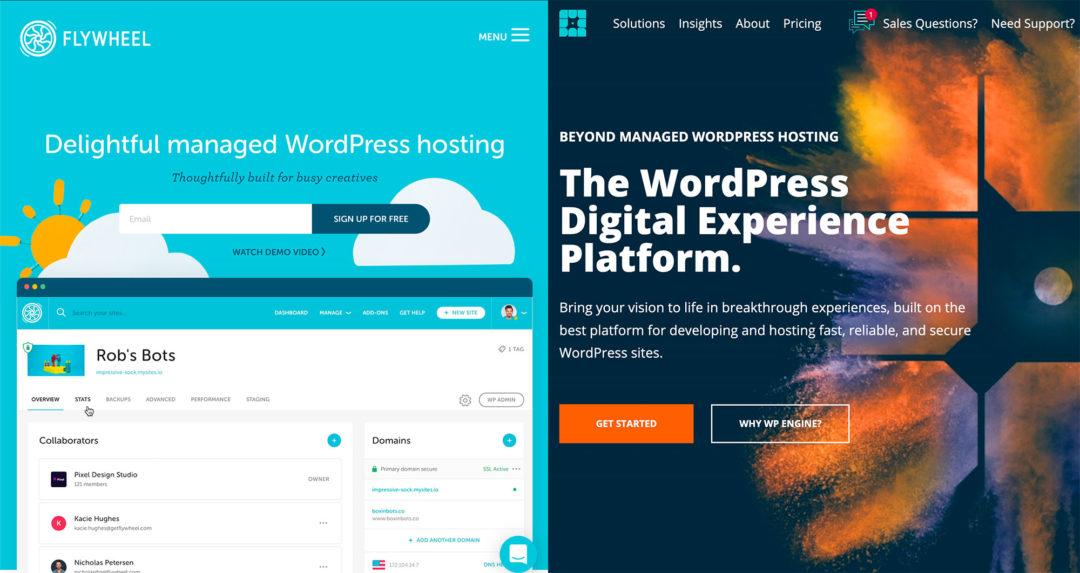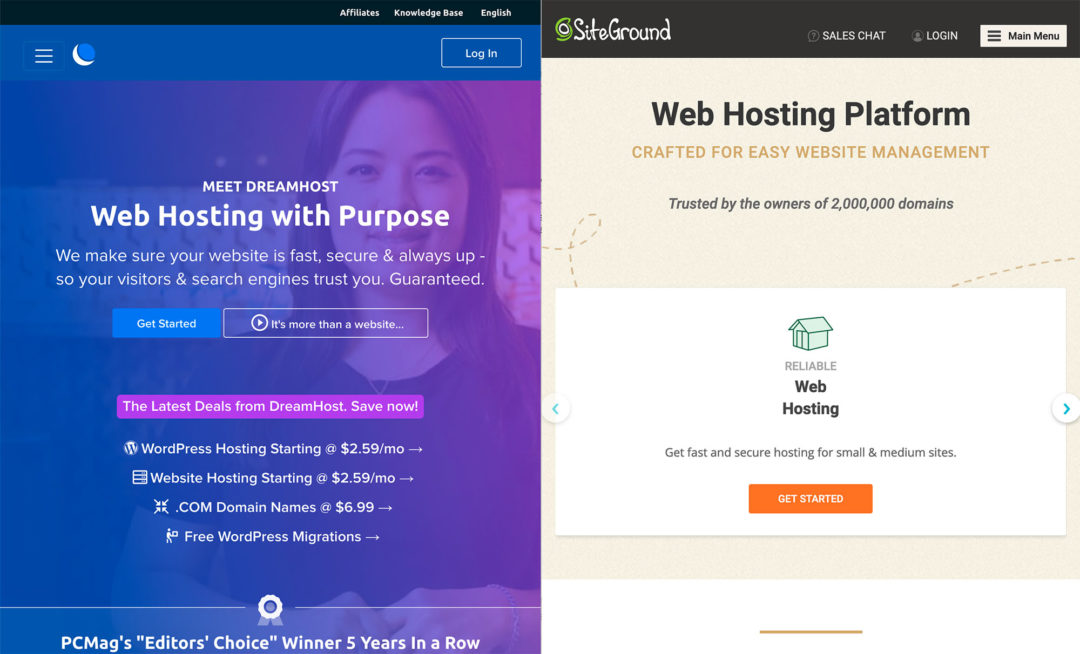Struggling to pick between Bluehost vs DreamHost to host your WordPress website?
In the budget WordPress hosting space, Bluehost and DreamHost are two of the biggest names, so it makes sense that you’d narrow down your search to these two titans. But, while they both offer cheap WordPress hosting, there are some key differences that may push you in one direction or the other.
For example, DreamHost are both cheaper and offer better performance (in my tests, at least), which is why I recommend DreamHost as the best option for most people looking to launch a WordPress site on a budget. However, Bluehost have the advantage of offering cPanel access, along with a very well-designed and user-friendly custom hosting dashboard, which may make them a better choice in some situations — such as if you’re a total newbie who wants the simplest way to launch a WordPress website.
💡 Note: looking for higher-performance WordPress hosting? Check out this other post of ours comparing Kinsta and WP Engine.
I’m getting ahead of myself, though, because to understand where those conclusions have come from, you really need to read the full comparison.
Let’s dig in!
Table of Contents
Features
To kick things off, let’s go through the features you get with both Bluehost and DreamHost. I never like to devote too many words to this section because you can find all of these details in the marketing copy, but I think it’s useful to go through a quick comparison, so you can see how the two hosts stack up.
If I mark a feature with a ✅ emoji, it means it’s unique to the host — or, in some situations, it means one host offer a feature on all of their plans, while the other host only offer it on limited plans.
Bluehost
- Automatic WordPress installation
- Custom hosting dashboard
- ✅ cPanel access
- Unlimited websites (except on the cheapest plan)
- Unlimited storage (except on the cheapest plan)
- Unmetered bandwidth
- ✅ Free email hosting on all plans (DreamHost charge extra on their cheapest plan)
- Automatic WordPress updates
- Free SSL certificates via Let’s Encrypt
- ✅ Staging sites on all plans
- Automatic CodeGuard backups (only on the most expensive plan)
- Built-in caching
- Free domain name
DreamHost
- Automatic WordPress installation
- Custom hosting dashboard
- Unlimited websites (except on the cheapest plan)
- Unlimited storage (except on the cheapest plan)
- Unmetered bandwidth
- Free email hosting on the higher-tier plan, extra fee on the cheapest plan
- Automatic WordPress updates
- Free SSL certificates via Let’s Encrypt
- ✅ Automatic daily backups on all plans (Bluehost only offer automatic backups on their highest-tier plan)
- Free domain name
- ✅ Free domain privacy/WhoIs protection (Bluehost charge extra)
Performance
Now, it’s time to get into the more hands-on sections of this comparison.
Performance is one of the most important considerations with any web host, because how quickly your website loads will affect your visitors’ user experience, your search engine optimization (SEO) and even your conversion rates if you’re using your website to sell something.
Basically, if one host loads your site faster than the other, that’s a big advantage for the faster web host. And, when it comes to performance, DreamHost are the overall winner.
To analyze how these two hosts compared, I set up an identical test site on both Bluehost and DreamHost. My test site used the Genesis Framework and the Authority Pro child theme, and I then imported the full Authority Pro demo site to create a realistic scenario.
Beyond that, I didn’t make any changes. That is, everything else was the default experience as configured by each host’s WordPress autoinstaller tool.
Then, I used Pingdom to set up automatic performance monitoring over an entire week. I configured Pingdom to run a speed test every 30 minutes from the following locations:
- Eastern USA
- Western USA
- Europe
For reference, my DreamHost data center is in Oregon, USA and my Bluehost data center is in Utah, USA.
For each location, there are ~336 different data points, which eliminates single-test variability. Then, Pingdom took the median value of all of those tests.
Overall, DreamHost performed better in two out of three tests — and in the one test Bluehost won, the speeds were very close:
| Bluehost | DreamHost | |
|---|---|---|
| Eastern USA | 2.01 s 🏆 | 2.13 s |
| Western USA | 2.14 s | 1.20 s 🏆 |
| Europe | 2.95 s | 2.56 s 🏆 |
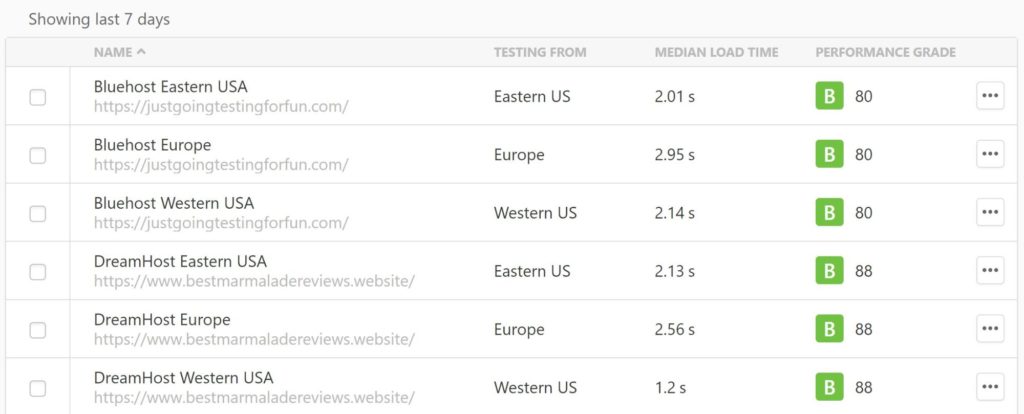
Note: If you’re wondering why Bluehost’s Performance Grade is only 80 but DreamHost’s is 88, the difference is that DreamHost appear to enable browser caching by default, while Bluehost don’t. That is, the test sites are identical — the only difference is in the default hosting configuration.
Overall, because DreamHost outperformed Bluehost in two out of three locations and were almost equal in the third, I feel confident saying they’re the winner when it comes to performance.
Dashboard/User Experience
If you’re looking at cheap shared hosts, such as DreamHost and Bluehost, user-friendliness is probably another big consideration in your choice.
Both hosts offer custom dashboards that do a good job of making it easy to manage key aspects of your site. However, I’d say Bluehost have the edge when it comes to the dashboard experience/user-friendliness.
Additionally, while Bluehost have built their own custom dashboard, they also still give you access to cPanel; on the other hand, DreamHost’s dashboard is 100% custom. That is, they don’t give you cPanel.
Bluehost Dashboard
As I mentioned above, Bluehost have a unique hybrid approach where they give you a custom dashboard for day-to-day site management, while still giving you access to cPanel if you need it.
For each site, you get a detailed area where you can manage key information. One really nice feature here is that, if you’re using WordPress, you can manage important parts of your WordPress site from this area:
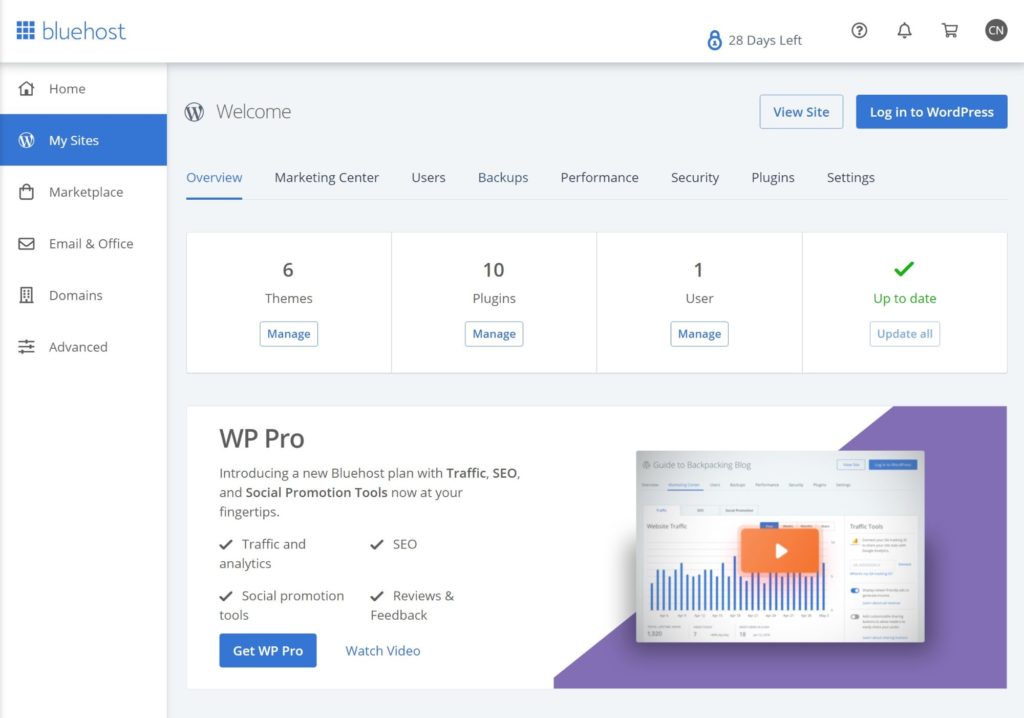
For example, if you go to the Plugins tab, you can activate/deactivate plugins and even update them:
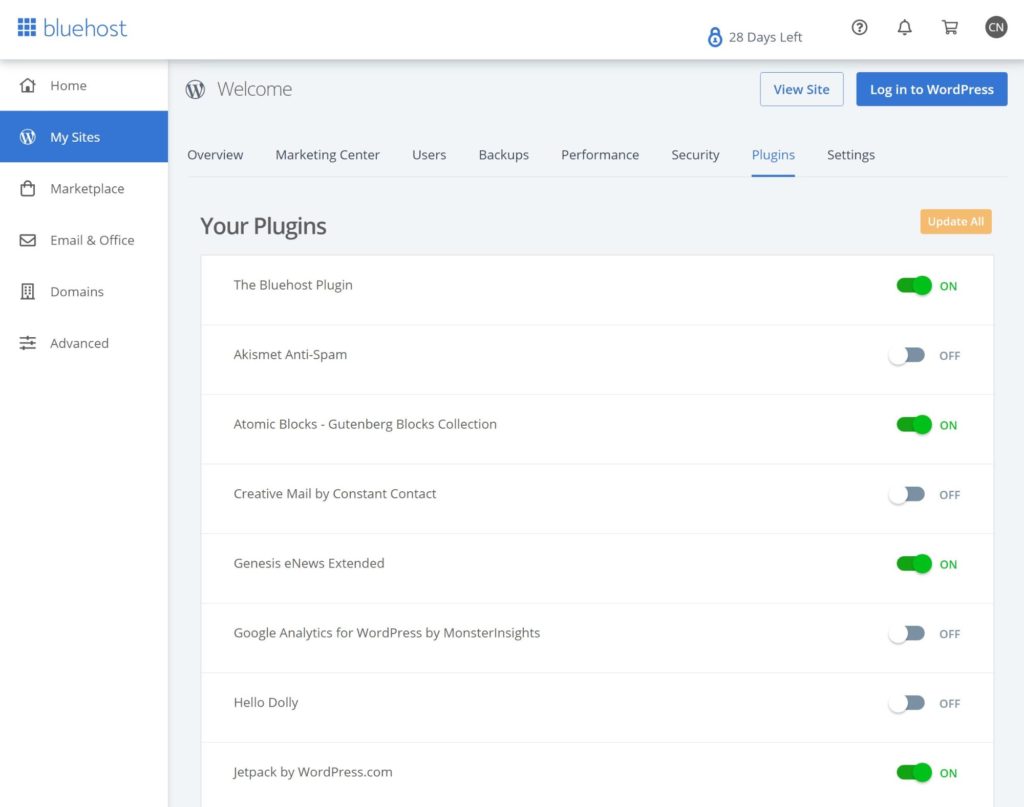
The Performance tab also lets you adjust your site’s caching or quickly enable a free CDN via Cloudflare:
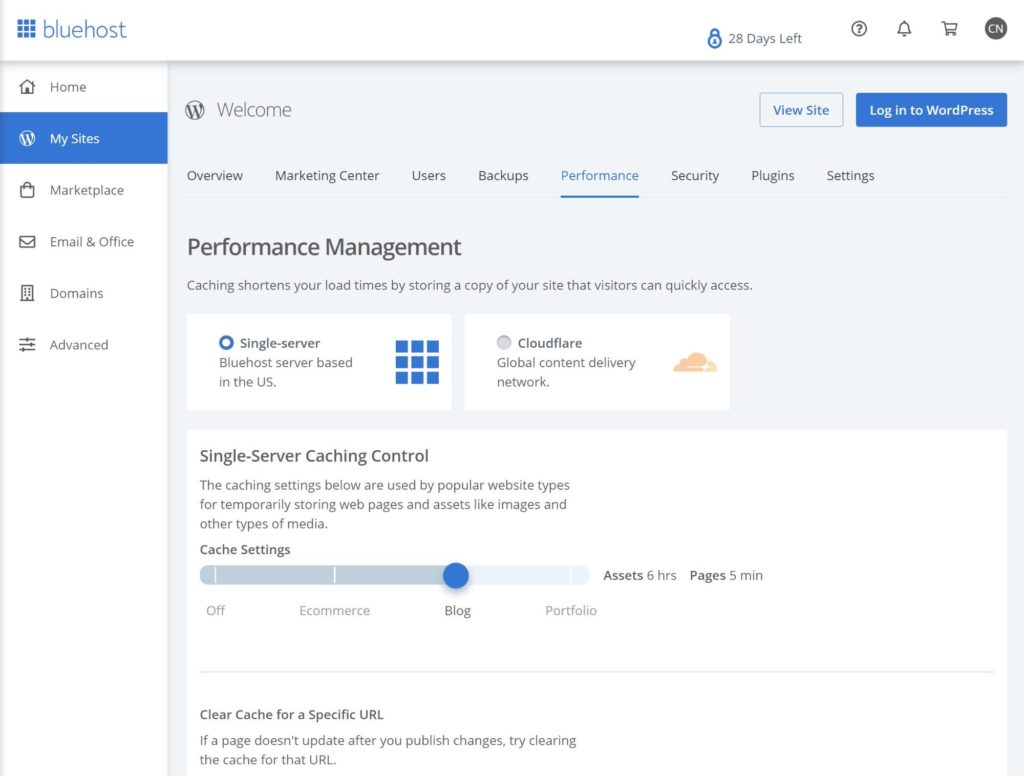
Overall, this dashboard is really well done and, at least in my opinion, it’s one of Bluehost’s biggest selling points. Put simply, if you’re a beginner, I think you’ll have a really easy time launching a working website with Bluehost.
However, if there’s something you can’t do with the custom dashboard, you can always head to the Advanced tab to access cPanel and all of the normal cPanel tools, including File Manager, phpMyAdmin for database editing, and lots more:
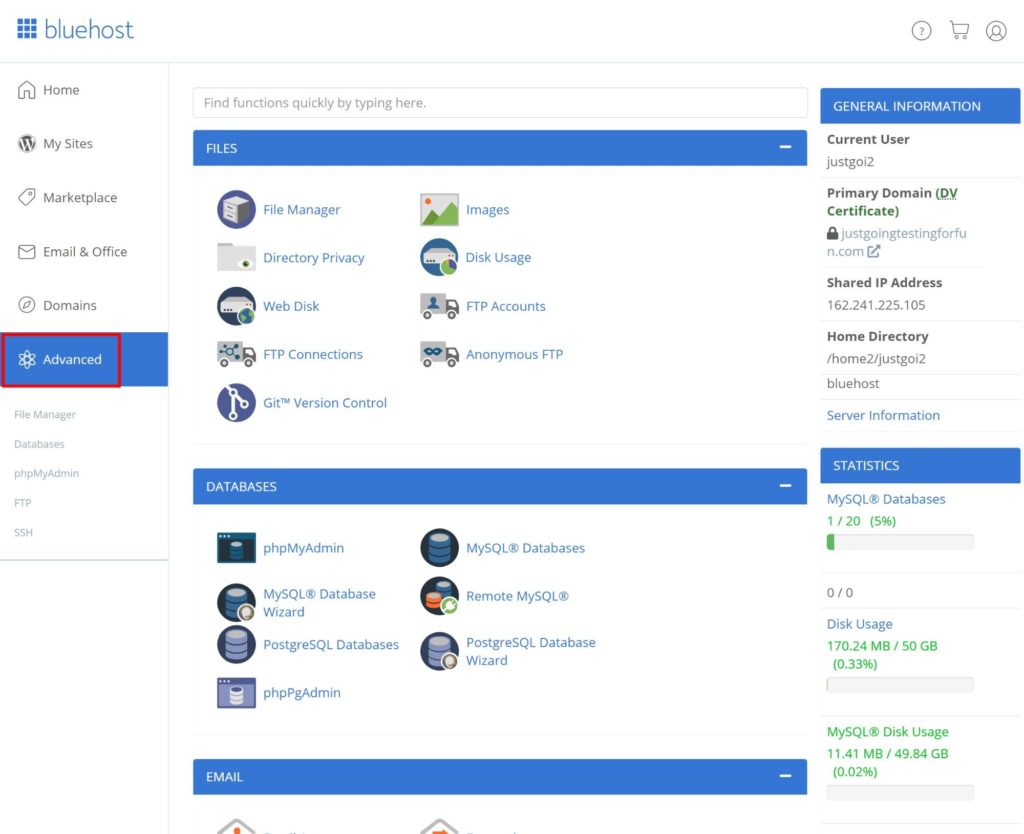
Having access to cPanel is another advantage of Bluehost because DreamHost do not give you cPanel.
DreamHost
While I think Bluehost win when it comes to dashboard experience, that doesn’t mean DreamHost are bad. If you compared DreamHost with many other hosts, DreamHost would look pretty good — it’s just that Bluehost have one of the best dashboard experiences of any shared host, so they’re tough competition.
First, though, the bad news — DreamHost don’t offer standard cPanel, as I’ve mentioned a couple of times. You can only manage your site through DreamHost’s custom dashboard. If you’ve built cPanel into your workflows, that may be disappointing for you. However, if you’re not familiar with what cPanel is, you probably won’t care either way because DreamHost’s custom dashboard still lets you do pretty much everything you need.
The main dashboard gives you a quick summary of your site and links to key areas. You can also move around by using the menu on the top-left:
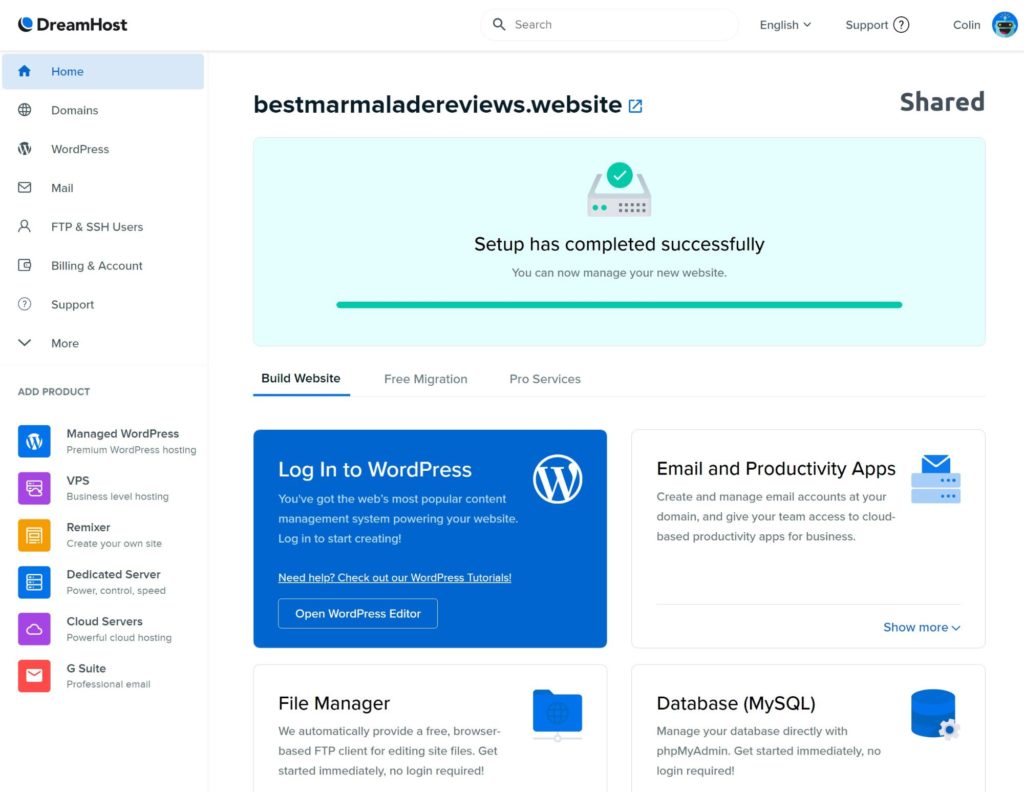
There are some slightly odd choices. For example, if you want to manage one of your WordPress installs, you actually need to look for the Websites option under the Domains section. This will let you access most of your site’s settings from one list:
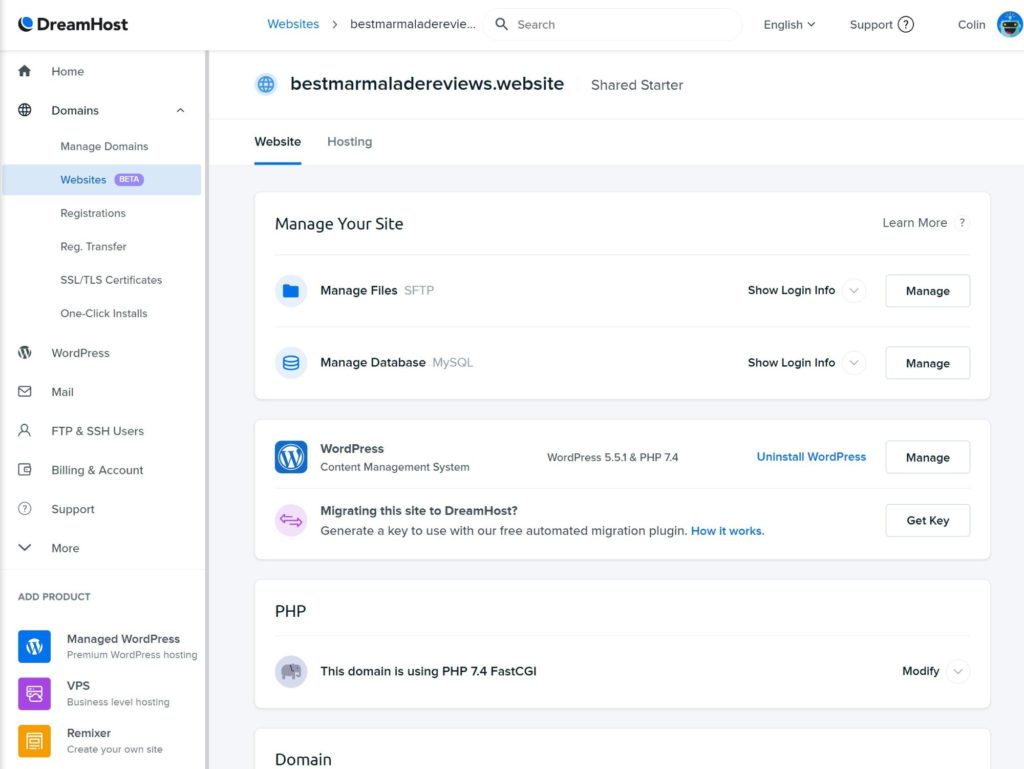
You’ll also get other useful tools, such as an in-dashboard file manager, phpMyAdmin for database access, Cron jobs and more.
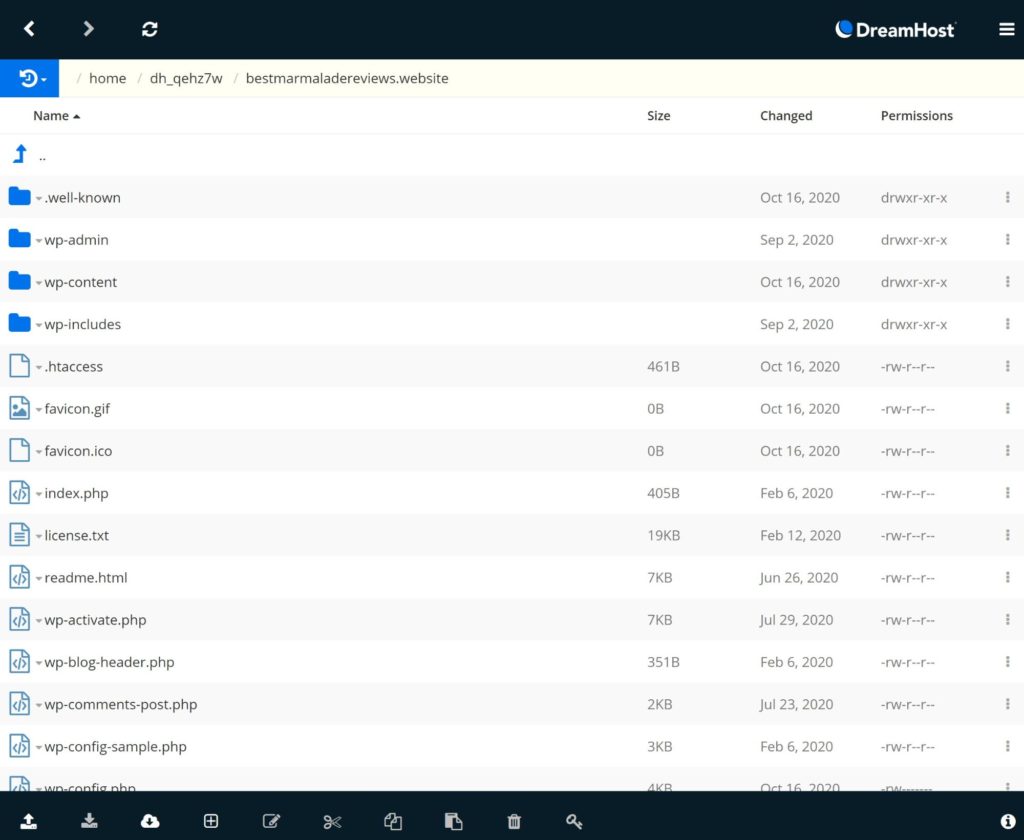
Overall, though, I just don’t feel like DreamHost’s dashboard is as intuitive and streamlined for casual users as Bluehost’s is. That, combined with Bluehost giving cPanel access, is why I give the nod to Bluehost.
Pricing
Comparing Bluehost’s pricing vs DreamHost’s pricing can be tricky because there are a lot of variables. However, in general, DreamHost are the winners here because they’re cheaper than Bluehost, offer more transparent pricing and let you pay monthly.
When trying to compare prices in the budget shared hosting space, it’s important to consider two variables:
- Promotional vs regular prices — most shared hosts offer big ‘discounts’ on your first billing cycle (which can be up to three years). However, when you go to renew, you’ll then need to pay full price, which can easily be double or triple the promotional prices.
- Term lengths — most shared hosts only give you the cheapest prices if you pay for three years upfront. Usually, you see the ‘three-year’ price on the pricing page and you’ll pay higher amounts if you go with a shorter billing cycle.
DreamHost make it very easy to see how these different variables affect the price, while Bluehost make it very difficult. This is why I say DreamHost have more ‘transparent’ pricing.
Let’s talk about each host’s pricing in a vacuum first. Then, I’ll compare them and also try to account for all of those variables.
Bluehost
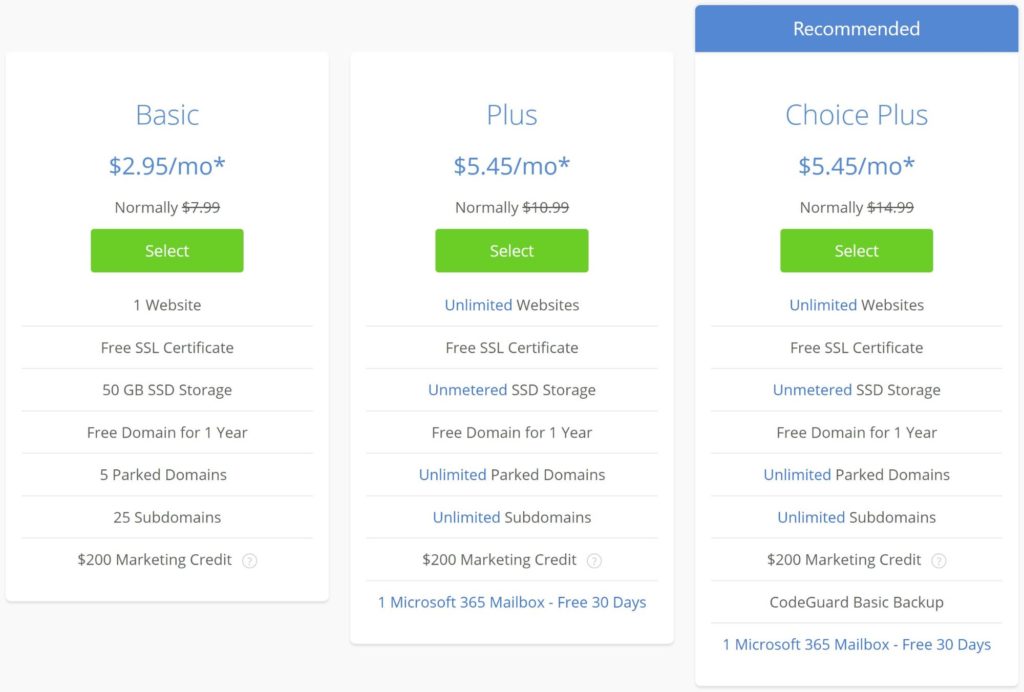
Bluehost offer three different shared plans:
- Basic — one website.
- Plus — unlimited sites.
- Choice Plus — unlimited sites plus automatic backups.
The Plus and Choice Plus plans have identical promotional prices, though different renewal prices. In my opinion, this is mainly a smart marketing tactic to make you think the Choice Plus plan is a ‘no-brainer’, so to speak.
You can choose from three different billing cycles:
- One year
- Two years
- Three years
Bluehost do not let you pay monthly on their shared plans, though. DreamHost do allow this, which you’ll see in a second.
| One Year | Two Years | Three Years | |
|---|---|---|---|
| Basic Promo/mo. | $4.95 | $3.95 | $2.95 |
| Basic Regular/mo. | $8.99 | $8.49 | $7.99 |
| Plus Promo/mo. | $7.45 | $6.95 | $5.45 |
| Plus Regular/mo. | $12.99 | $11.99 | $10.99 |
| Choice Plus Promo/mo. | $7.45 | $6.95 | $5.45 |
| Choice Plus Regular/mo. | $16.99 | $15.99 | $14.99 |
As you can see, there are some big differences between the promo prices and the regular prices. In some situations, the regular prices are almost 3X the promo prices.
DreamHost
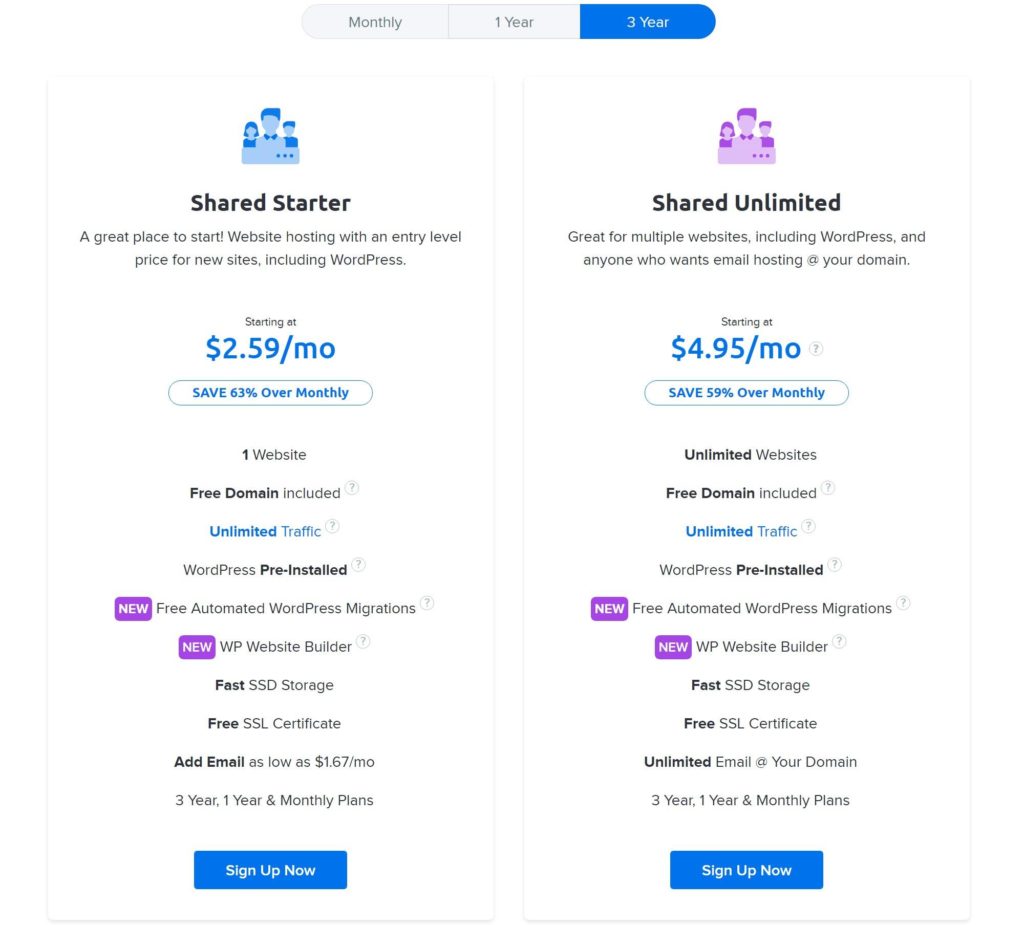
DreamHost offer only two plans:
- Starter — allows for one website.
- Unlimited — allows for unlimited websites.
You can then choose from three different billing cycles:
| Monthly Billing | One Year | Three Years | |
|---|---|---|---|
| Starter Promo/mo. | $4.95* | $3.95 | $2.59 |
| Starter Regular/mo. | $6.99 | $3.95 | $2.59 |
| Unlimited Promo/mo. | $10.95* | $4.95 | $4.95 |
| Unlimited Regular/mo. | $11.99 | $9.95 | $7.95 |
*For your first three months
If you’re on the Starter plan, you’ll also need to pay an extra $1.67 a month for email hosting (which Bluehost don’t charge you extra for).
Bluehost vs DreamHost Pricing
In general, DreamHost are cheaper than Bluehost. To make that easier to see, here’s a table that compares the one-year prices for the following equivalent plans:
- DreamHost Starter vs Bluehost Basic — one website.
- DreamHost Unlimited vs Bluehost Choice Plus — unlimited websites with automatic backups.
| DreamHost Starter | Bluehost Basic | DreamHost Unlimited | Bluehost Choice Plus | |
|---|---|---|---|---|
| Promo Price | $3.95 | $4.95 | $4.95 | $7.45 |
| Regular Price | $3.95 | $8.99 | $9.95 | $16.99 |
As you can see, unless you’re willing to pay for three years upfront to get the cheap Bluehost prices, DreamHost are actually significantly cheaper than Bluehost — it’s just hard to figure this out because Bluehost aren’t very transparent with the many variables that go into their prices.
Additionally, DreamHost also let you pay monthly, which is something Bluehost don’t allow. If you can’t afford a big upfront cost, this is another big advantage for DreamHost.
Support
Both hosts give you 24/7 support if you need it. However, Bluehost are a little more flexible in how you get support.
Bluehost give you support via live chat, phone or ticket/email and all of their channels are available 24/7.
DreamHost, however, only give you free support via email and live chat. Additionally, live chat support is only available from 5.30am to 9.30pm PT. While that should work fine if you’re based in the USA, it may be frustrating if you’re located elsewhere. To be clear, DreamHost offer 24/7 email/ticket support — it’s just the live chat option that has limited hours.
DreamHost also give you the option to request a phone callback for an extra fee. You can either pay monthly for a certain number of callbacks per month or pay a one-time fee for a single callback. Additionally, phone callbacks are only available from 6am to 10pm PST.
Now, while that would seem to give the clear edge to Bluehost, I’m actually still going to give the slight edge to DreamHost. Why? Because of support quality.
To recap:
- In terms of availability, Bluehost win because they give you phone support and both phone/live chat are available 24/7.
- In terms of quality, DreamHost are ahead.
You’ll need to decide which aspect of support you value more.
Recapping Bluehost vs DreamHost
As we finish this comparison, let’s recap some of the biggest differences between Bluehost and DreamHost. Here are each host’s strong points in comparison with the other:
Bluehost
- At least personally, I find Bluehost’s dashboard to be more user-friendly. For example, Bluehost let you manage WordPress settings and plugins from the hosting dashboard. This is somewhat subjective, though, and DreamHost are still better than most shared hosts.
- Bluehost still give you access to cPanel, whereas DreamHost use a 100% custom dashboard.
- Bluehost offer phone support at no extra cost.
- All of Bluehost’s support channels are available 24/7.
DreamHost
- DreamHost performed better than Bluehost in the performance tests.
- DreamHost are usually cheaper when you factor in all of the different pricing variables.
- DreamHost let you pay monthly, whereas the shortest period with Bluehost is one year.
- DreamHost offer automatic backups on all of their plans, whereas Bluehost only do so on the Choice Plus plan.
- DreamHost’s support quality is generally rated as better than Bluehost’s.
Which Host Should You Choose?
Now for the important question — which host should you pick when it comes to Bluehost vs DreamHost?
For most people, I’d recommend starting with DreamHost. Here’s why:
- DreamHost performed better in our performance tests, which is one of the most important features to look for in any host.
- DreamHost offer more flexible billing. For example, you can pay monthly. Bluehost try to lock you into three-year contracts by only offering the best discounts for three-year plans.
- DreamHost are cheaper when you consider non-promotional prices. So, while DreamHost may seem a little more expensive at first glance, that’s really just because DreamHost are more transparent with their prices.
- While I didn’t find DreamHost’s dashboard to be quite as user-friendly as Bluehost, it’s still quite good and has all of the features most people need.
One area where Bluehost do excel is when it comes to beginner-friendliness. Again, DreamHost aren’t bad for beginners, it’s just that Bluehost are better. Still, I think DreamHost’s other benefits outweigh this, unless you feel very overwhelmed by the idea of creating a WordPress website and just want the absolute simplest option.
Another consideration for some people may be cPanel access — Bluehost still give you access to cPanel while DreamHost don’t. So, if cPanel is really important to you, then that may be another reason to pay a little extra for Bluehost.
Overall, though, DreamHost are the better choice for most people who want to make a WordPress site. If you want to get started, click here to go to DreamHost. DreamHost offer a lengthy 97-day money-back guarantee, so you have plenty of time to change your mind if you’re not happy with anything.
Related Reading:
Used/using either of these hosts? Thoughts?
Discover more from WPMarmalade
Subscribe to get the latest posts sent to your email.


